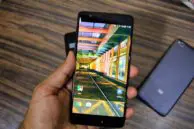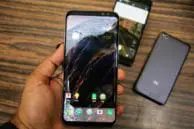
Last year, Samsung managed to sell its flagship handset — the Galaxy S7 and S7 edge — in excess of 45+ million units and that was despite the ill-fated Galaxy Note 7. This year, if the early impressions of the Galaxy S8 and S8+ are anything to go by, Samsung is on track for another bumper year.
However, not everyone has the money to buy flagship smartphones. And considering just how much mid-range Android smartphones have improved in the last couple of years, you really need to have a strong reason to not buy them and instead go for one of Samsung’s flagship handset. Leading the mid-range Android smartphone charge is OnePlus’ excellent OnePlus 3/3T. Released last year, the handset might not have sold as much as the Galaxy S7, but it did win plenty of accolades and continues to remain the favourite phone of consumers and reviewers.
So, how does the OnePlus 3T compare to the Samsung Galaxy S8? The former is almost six months old at this point, while the Galaxy S8 is Samsung’s latest flagship which is filled to the brim with all the new features and technology. However, the Galaxy S8 costs almost double of the OnePlus 3T. Is the extra price worth it though?
Design and Build Quality
The Samsung Galaxy S8 is easily the most beautiful and well-built phone launched in recent times. The Infinity Display, the curved rear and front glass, and the metal chassis on the Galaxy S8 come together in such a way that gives it a very premium look and feel. The OnePlus 3T with its metal unibody design also feels premium and the Midnight Black edition looks pretty stealthy as well, but it cannot match up to just how premium the Galaxy S8 feels.
There are pros and cons of the build of both phones though. Since the Galaxy S8 makes extensive use of glass, it is prone to shattering despite the use of Gorilla Glass panels. The lack of bezels surrounding the Infinity Display does not help things either, with the display particularly prone to shattering if the handset is dropped face down. The glass panel at the rear of the Galaxy S8 also makes it a fingerprint magnet. This essentially makes it a must to use a case with the handset.
On the other hand, the OnePlus 3T with its unibody will hold up better during a fall, though it will get some dents and scuffs here and there over time. The unibody design of the handset does make it very slippery which makes using the case a must. And while the Soft Gold and Grey color of the OnePlus 3T do not attract fingerprint, the Midnight Black edition is an oil and fingerprint magnet.
Display

The Galaxy S8 and S8+ come with a 5.8-inch and 6.2-inch Quad HD+ curved Super AMOLED display with an 18.5:9 aspect ratio, while the OnePlus 3T comes with a 5.5-inch Full HD Optic AMOLED display. The size bezels on the OnePlus 3T are very small, but the handset does have a certain amount of bezels at the top and bottom. The Galaxy S8 and S8+ with their Infinity Display feature an almost bezel-less design that looks very futuristic.
In terms of display quality, there is almost a no contest between the two devices. The Galaxy S8’s AMOLED panel is brighter, more color accurate, vibrant, bigger, and more power efficient. The AMOLED panel on the OnePlus 3T is strictly ok, and while it does not falter in any specific area barring color accuracy, it cannot quite match the AMOLED panels of the Galaxy S8 and S8+.
It’s not that the display of the OnePlus 3T is bad. It is more than good enough for most users out there, but it’s just that the display on the Galaxy S8 is so much better.
Software and Performance

The OnePlus 3T and Samsung Galaxy S8 heavily differ from each other in the software department. While the 3T runs on OxygenOS that is based on a near-stock build of Android with some enhancements thrown in, Samsung’s Experience UI — it’s not called TouchWiz anymore — comes with plenty of features and customizations that are not present in stock Android. The UI also does not look anything like stock Android, with Samsung customising almost every aspect of the OS to add its own touch to it.
If you are a fan of stock Android, you are going to love OxygenOS on the OnePlus 3T. It is even based on Android 7.1.1 Nougat, unlike the Galaxy S8 which still runs on Android 7.0. Samsung has worked on its UI from its Galaxy S3 and S4 days and now the UI does not look like it was designed by kids. The company has also worked on reducing the sheer number of bloatware it ships on its devices and has made most of its own apps available as an optional download through its Galaxy Apps store on the Galaxy S8.
The Galaxy S8 clearly packs a more feature-loaded skin with handy features like floating window multitasking, themes, one-handed mode, and more. However, the additional features and pre-installed apps also affect its performance. Despite coming with a more powerful chipset, the Galaxy S8’s skin is clearly not optimised enough for smoothness. While the jerks and skipped frames are reduced compared to previous flagship devices, the OnePlus 3T just feels faster and smoother in regular use compared to the Galaxy S8.
If there is one area where the OnePlus 3T really blurs the line between being a mid-range smartphone and a flagship smartphone like the Galaxy S8, it has to be in terms of performance.
Camera

If there’s one area where the Galaxy S8’s proves its worth, it’s in the camera department. The 12MP Dual Pixel f/1.7 aperture shooter of the Galaxy S8 is significantly better than the 16MP f/2.0 shooter of the OnePlus 3T.
The wider aperture, bigger pixels, OIS, a better camera sensor, and a better ISP all help in allowing the Galaxy S8 to capture significantly better photos than the OnePlus 3T. In fact, the S8’s rear shooter is among the best found in a smartphone right now. The OnePlus 3T’s camera is able to hold its own in daylight, but as the available light reduces, the phone really starts struggling and starts showing its weakness. The Dual Pixel AF technology on the Galaxy S8 is also significantly better than OnePlus 3T’s PDAF tech, which starts struggling with focus in low-light situations.
- Samsung Galaxy S8
- OnePlus
- Samsung Galaxy S8 HDR
- OnePlus 3T HDR
- Samsung Galaxy S8
- OnePlus 3T
Conclusion
Samsung’s latest flagship, the Galaxy S8 and Galaxy S8+, are great phones by all means. The Infinity Display, great build quality, a truckload of customisation options, excellent camera, and features like wireless charging and IP68 certification make them the phones to have, provided you have the money to spend.
But do you really need a phone like the Galaxy S8? If you just need a workhorse of a smartphone and don’t really care about having the best camera, design, or display, the OnePlus 3T will do just fine. And as a bonus, its performance is not going to deteriorate like the Galaxy S8 over time. OnePlus has also been pretty quick in rolling out Android OS updates to the OnePlus 3 and 3T, though the company does not roll out monthly security updates like Samsung does for the unlocked variant of its flagship handset.
How much are you willing to spend on your smartphone: $439 vs $725? Drop a comment and let us know!

















